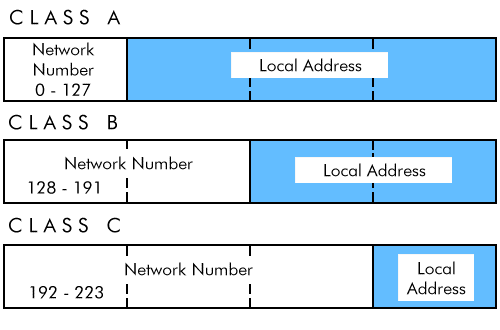
| Class | Length of network address (octets) |
First number | Number of local addresses |
|---|---|---|---|
| A | 1 | 0-127 | 16,277,216 |
| B | 2 | 128-191 | 65,536 |
| C | 3 | 192-223 | 256 |
The IP protocol uses IP addresses to identify hosts and to route data to them. Every host must be assigned a unique IP address that can be used in actual communications. A host name is translated into its IP address by looking up the name in a database of name-address pairs.
An IP address is a 32-bit (4-octet) binary number. The resulting address space (which is the set of all possible address numnbers) contains 232 (4,294,967,296) numbers.
The dot notation was invented as a way of reading and writing IP addresses easily. Each octet (8 bits) of the address is converted into a decimal number, and the numbers are separated by dots. For example, the address for technology.niagarac.on.ca in 32-bit binary and in dot notation is:
11000000.11000101.01111110.00100011 192.197.62.35
Note that the biggest number that can appear in any position of a dotted address is 255, which corresponds to the binary number 11111111.
An IP address has a two-part format consisting of a network address and a local address. The network address identifies the network to which the node is attached. The local address identifies an individual node within the organization's network.

| Class | Length of network address (octets) |
First number | Number of local addresses |
|---|---|---|---|
| A | 1 | 0-127 | 16,277,216 |
| B | 2 | 128-191 | 65,536 |
| C | 3 | 192-223 | 256 |
Class D addresses start with a number between 224 and 239, and are used for IP multicasting. Multicasting distributes a message to a group of computers dispersed across a network.
Class E addresses are reserved for experimental use, and start with a number between 240 and 255.
Several blocks of addresses have been reserved for use for networks that will not be connected to the Internet and will never require connectivity to another organization. These addresses include:
10.0.0.0 - 10.255.255.255 172.16.0.0 - 172.31.255.255 192.168.0.0 - 192.168.255.255
Note that many organizations will be using these addresses.
A Class A network spans 16,277,216 addresses, while Class B supports 65,536 and Class C only includes 256 numbers. The large gaps between these numbers led to very inefficient address block allocations and contributed to the depletion of the IP address space.
 Back to the ELNC1221 Page
Back to the ELNC1221 Page